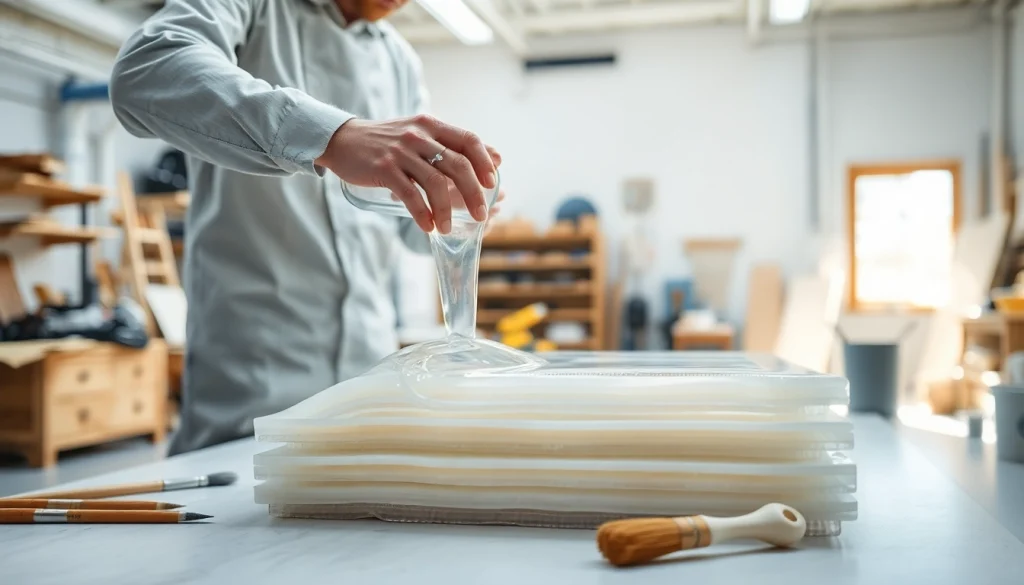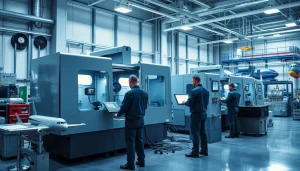Essential Insights on Laminating Resin: Usage, Benefits, and Techniques

Understanding Laminating Resin
What is Laminating Resin?
Laminating resin is a specialized form of resin used primarily in composite material applications. Its distinct properties make it an essential component in various industries, especially in fiberglass fabrication. Essentially, laminating resin acts as a bonding agent, allowing multiple layers of materials to adhere securely together. This resin type is known for its high strength and durability, making it ideal for applications requiring both flexibility and structural integrity. Typically found in both polyester and epoxy formulations, laminating resin offers flexibility depending on the specific requirements of the project at hand.
Types of Laminating Resin Available
There are several types of laminating resin available, each with unique characteristics to suit different applications:
- Polyester Laminating Resin: This is the most common type used in marine applications and other industries. It is beneficial for its cost-effectiveness and excellent adhesion properties, as well as its resistance to water and chemicals.
- Epoxy Laminating Resin: Known for its superior strength and flexibility, epoxy laminating resin is often used in applications demanding greater mechanical properties and resistance to environmental stressors.
- Vinyl Ester Laminating Resin: Combining the benefits of both polyester and epoxy, vinyl ester is highly resistant to corrosion and impacts, making it suitable for use in chemical tanks and other industrial settings.
Common Applications of Laminating Resin
Laminating resin finds applications across a variety of industries. Some of the most notable include:
- Marine Industry: Utilized extensively in the construction and repair of boats and yachts, where durability and water resistance are crucial.
- Aerospace: Used in the fabrication of composite structures that require high strength-to-weight ratios.
- Automotive Manufacturing: Implements in making parts like panels and body structures, which benefit from the resin’s weight-saving properties and strength.
- Construction: Commonly used in making composite materials for structural reinforcements.
Benefits of Using Laminating Resin
Durability and Strength in Projects
One of the primary reasons builders and manufacturers choose laminating resin is its unmatched durability. Laminating resin provides a robust bond that can withstand various stresses, including impacts, vibrations, and environmental factors. When properly applied, it forms a resulting composite with a much higher tensile strength compared to the individual layers, significantly enhancing the overall integrity.
Cost-Effectiveness and Efficiency
Cost-effectiveness is another significant advantage of using laminating resin. Because it provides superior bonding and protects underlying materials from damage, projects see substantial savings during the long-term lifecycle. When the material lasts longer, the overall expenses for maintenance and premature replacements also decrease. Productivity often improves, as laminating resin can be applied efficiently, which helps speed up the construction or manufacturing processes.
Versatility Across Industries
Laminating resin’s versatility allows it to be used in various applications across different sectors. From building boats to creating custom molds in manufacturing and in construction, the adaptability of laminating resin expands across marine, automotive, aerospace, and many other industries. This adaptability also includes its ability to bond with various substrates, including fiberglass, carbon fiber, and wood, making it a go-to solution for many engineers and builders.
Best Practices for Laminating Resin Application
Preparation and Surface Treatment
Before applying laminating resin, preparing the surface correctly is crucial. The surface must be clean, dry, and free from any oil, grease, dust, or contaminants that can interfere with adhesion. Depending on the substrate, the following preparation steps are advisable:
- Cleaning: Use solvents or mild detergents to remove residues.
- Sanding: Lightly sand the surface to create a textured profile that promotes adhesion.
- Priming: In some cases, applying a primer can enhance bonding, particularly in non-porous materials.
Mixing and Curing Techniques
Proper mixing and curing of laminating resin play a vital role in the overall outcome and success of the application. Following the manufacturer’s instructions is essential to ensure the right ratio of resin to hardener is achieved. A common method includes:
- Mixing the resin and hardener in a clean, dry container.
- Using mechanical stirrers to ensure a thorough blend.
- Allowing the mixture to sit for a prescribed time to reach optimal working properties before application.
Curing techniques can vary, but maintaining ideal temperature conditions and allowing adequate time for the material to set is fundamental for achieving the desired mechanical properties.
Safety Precautions when Using Laminating Resin
Working with laminating resins necessitates awareness of safety precautions to mitigate health risks. Key safety practices include:
- Wearing appropriate personal protective equipment (PPE) such as gloves, goggles, and respirators.
- Ensuring adequate ventilation in work areas to avoid inhaling fumes.
- Following all handling and storage instructions provided by the manufacturer, as some resins may be flammable or hazardous.
Challenges and Solutions in Laminating Resin Use
Understanding Curing Issues and Fixes
Curing issues can arise due to various environmental factors, including temperature fluctuations and humidity levels. Common problems include incomplete curing, which can lead to weaker bonds and surface defects. Solutions involve:
- Monitoring and controlling the temperature and humidity of the workspace.
- Using additives that can help speed up curing or modify the resin’s properties to suit environmental conditions.
Dealing with Surface Imperfections
Surface imperfections such as bubbles, uneven finishes, or poorly laid layers may occur. To remedy these issues:
- Identify the source of the imperfection, whether it’s due to mixing, application techniques, or environmental conditions.
- Sand down the affected area and apply additional layers of resin as needed to achieve a smooth finish.
- Implementing consistent application techniques can help reduce the perceived risk of surface imperfections.
Environmental Considerations in Laminating Resin Use
As global environmental concerns rise, it’s essential to consider the environmental impact of using laminating resin. Preferential adoption of eco-friendly formulations and awareness of disposal methods can mitigate adverse effects:
- Choosing bio-based or low-VOC laminating resin options to minimize emissions.
- Establishing proper waste management and recycling methods for used materials, as many laminating resins can be recycled under the right conditions.
Future Trends and Innovations in Laminating Resin
Biobased and Eco-Friendly Options
With the growing emphasis on sustainability, the market for biobased and eco-friendly laminating resins is expanding. Innovations in materials science are allowing the formulation of resins derived from renewable resources that offer similar, if not superior, performance metrics compared to traditional petroleum-based options. Users can expect to see more product lines aimed at reducing their carbon footprint while maintaining optimal performance.
Advancements in Manufacturing Processes
Modern manufacturing processes continue to evolve, allowing for greater efficiency and reduced waste in resin production. Techniques such as automated mixing and application systems help improve overall product consistency while minimizing the potential for human error. These advancements lead to a higher quality end product, ensuring that users can confidently rely on the mechanical integrity and performance of their laminating resin applications.
Market Trends Affecting Laminating Resin Applications
As industries continuously seek ways to improve processes and performance, market trends such as the demand for lightweight and high-strength materials, increased regulatory standards, and rising competition are driving the development and refinement of laminating resin formulations. Future applications could include more sophisticated composite designs, as well as the integration of smart technologies, allowing for real-time monitoring of material properties.






